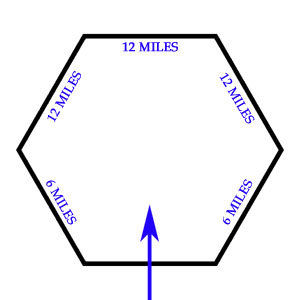It’s time to explore Hell itself on the war-torn plains of Avernus!
… except there’s a problem.
Descent Into Avernus frequently talks about how the PCs are going to be “exploring” Avernus. Unfortunately, it goes out of its way to stop them from doing that in almost every way possible.
For example, it’s impossible to make a map. And the reason it’s impossible to make a map is because navigation is meaningless. Descent Into Avernus revamps the metaphysics of the Lawful Evil plane of Avernus into a chaotic, ever-shifting place where direction and distance are unfathomable and any attempt to make a map drives the cartographer insane. If the PCs attempt to go somewhere, you just roll a completely random die to determine if they get there or not.
Why have they done this?
I honestly have no idea
Despite maps being both impossible and meaningless, the adventure nevertheless gives the players a poster map (pictured above).
It’s unlabeled and, again, the spatial relationships it depicts don’t actually exist, so it’s utterly useless for literally anything you might actually use a map for. The map also doesn’t include Elturel (where the PCs would begin their exploration of Avernus) or Fort Knucklebones (the first place they’re likely to be going), but the DM is instructed to put these locations anywhere on the map they want. (Although, once again, this is totally meaningless.)
The module actually says:
Your players should never feel like they understand Avernus geographically, providing an unsettled and disorienting feeling as they roam the hellscape.
And, to be clear, this is not how things used to work in Avernus. The designers of Descent Into Avernus did this deliberately. They repeatedly sell the experience – in both marketing and the book itself – as “exploring” Avernus, but then go out of their way to discard the existing lore and the established 5th Edition rules for wilderness travel in order to create a custom experience designed to make actual exploration completely impossible.
I should mention that the one thing the map DOES do is magically talk to the PCs: Every time they go somewhere, the map tells them exactly what the location is before they have a chance to explore and find out for themselves.
Without actually seeing it in the book, it’s difficult to believe the lengths Descent Into Avernus goes to in order to make sure that the players absolutely cannot explore Avernus in any possible way.
THE AVERNIAN HEXCRAWL
For the Remix, we’re basically going to just toss all of that out:
- The geography of Avernus will be comprehensible.
- Navigation (and therefore exploration) will be possible.
- The map the players receive will be meaningful.
To achieve this, we’ll be redesigning Avernus to use a hexcrawl scenario structure for wilderness exploration.
Now, one thing I’ve heard from a number of people while working on the Remix is that they’re really looking forward to seeing how I redesign Avernus as a sandbox. So I think it’s important to make something clear:
I am NOT going to be redesigning Avernus as a sandbox.
An RPG sandbox exists when the players can either choose or define what the next scenario of the campaign will be. For example, the opening chapters of Icewind Dale: Rime of the Frostmaiden are a sandbox.
Descent Into Avernus, on the other hand, isn’t a sandbox. It isn’t designed for the players to choose or define the scenario. The scenario is saving Elturel.
By using a hexcrawl structure to create a massively non-linear exploration experience while simultaneously blowing open the potential solution space for saving Elturel (as described in Part 6B: The Avernian Quest), we’re creating a huge playground in which the players will have enormous freedom to chart their own course through the campaign.
But, ultimately, they are not choosing their destination. Their destination is saving Elturel.
And this is significant because our design of the Avernian hexcrawl is going to be driven by that knowledge; it is going to be designed and structured for the PCs to save Elturel.
Now, with that being said, there are almost certainly going to be a lot of sandbox-like elements in our Avernian hexcrawl, and the hexcrawl itself is a very robust and flexible structure. So if you (or your PCs) were to ditch the idea of saving Elturel, it would probably be just a hop, skip, and a jump to use the Avernian hexcrawl as the basis for a pretty cool sandbox campaign. But there are meaningful structural changes and accompanying expansions of material that you’d want (or need) to make to truly shift the focus from saving Elturel and realize a fully functional and effective sandbox.
Note: There’s a fairly popular supplement called Avernus as a Sandbox. It’s also not a sandbox. They are misusing the term to just mean “non-linear scenario.” It’s actually a Choose Your Own Adventure structure. This is a really effective way of repackaging the Choose Your Railroad structure of the published campaign, but it’s not a sandbox.
MAKING THE HEX MAP
The first thing we’ll need for an Avernian hexcrawl is a hex map.
In designing the hex map, we’re going to want to keep the player’s map of Avernus in mind: If the players use their map to navigate, the navigational choices they make need to product coherent results when translated into the hexcrawl system.
(For example, they might be at the Hellwasp Nests and see, on their map, that the Demon Zapper lies to the “southwest.” If they tell the GM that they’re heading southwest, then when the GM plugs that movement into the hex map, they should generally end up at the Demon Zapper.)
The good news is that the player’s map is (a) illustrative instead of strictly representational and (b) lacks a scale. In other words, the only specific navigational information encoded into the map is a directional relationship (and even this can be arguably distorted by the imprecision of the illustrations). This gives us a great deal of latitude in tweaking the map.
(No pun intended.)
To create the map, I’m simply going to drape a hex grid over the top of the labeled DM’s version of the map:
In doing this, I’ve played around with the precise positioning of the grid to (as much as possible):
- Keep each location in a unique hex; and
- Maintain as many of the clear directional relationships as possible.
I’m fairly satisfied with the results here, so the next step is to start creating our hex key by assigning all the locations on the map to the corresponding hex. For example:
- A4 is the Arches of Ulloch
- B1 is Arkhan’s Tower
- C1 is the Monument to Tiamat.
- G6 is the Wrecked Flying Fortress.
And so forth.
MAP DIMENSIONS
I’ve used a 6 x 10 grid here, but because the player’s map has no scale, we have a pretty free rein in what the size of the hex map can be. (We could, for example, have just as easily made this a 10 x 20 grid or even distorted the map to achieve something like a 30 x 30 grid.)
In deciding the initial size of your hex map in a hexcrawl, there are basically two factors. First, you need to stock all these hexes with content, so you don’t want so many hexes that the task is overwhelming. Second, the hex map needs to be large enough that the PCs won’t immediately run off the edge of it and into uncharted territory.
(It’s quite likely they’ll eventually end up deciding to see what’s beyond the edge of the map, but if it happens in every single session including the first it can be problematic.)
In the case of Descent Into Avernus, we also have to consider the amount of time and narrative space we want to dedicate to exploring Avernus. If we had a 30 x 30 grid, for example, there would be 900 (!) hexes. That would probably mean spending twenty or thirty times longer in Avernus than the rest of the campaign combined (which would make it very difficult to maintain focus) OR it would mean the players only experiencing a tiny, tiny fraction of the hexcrawl (which would mean a ton of wasted prep).
Based on my experience, I generally recommend a 10 x 10 or 12 x 12 hex grid for an initial hexcrawl campaign (assuming the PCs’ homebase is located in the center of the map).
Our 6 x 10 map, therefore, is a little undersized in one dimension. I think this will be fine in practice because the existence of the map will act as a soft constraint on the PCs’ navigation: Having a map in hand focuses a group’s attention on the area depicted by the map, and they will tend to make their decisions within the confines of the map. There are also mountain ranges depicted to both the north and south, which will act as natural navigational constraints as well.
ADDING LOCATIONS
There are roughly two dozen locations described in Descent Into Avernus. So even after placing those locations, we’ll still have three dozen empty hexes that we’ll need to fill with new content. We’ll take a closer look at that in Part 7C: Avernian Hex Key.
However, among the existing locations, as mentioned above, there are two that need to be added to map: The Dock of Fallen Cities (where Elturel is currently located) and Fort Knucklebones.
These two locations need to be placed in relation to each other, as Lulu can hypothetically see Fort Knucklebones from the Dock of Fallen Cities. Furthermore, we know that the Dock of Fallen Cities is located on the Styx.
We could put both of these locations in a single hex, but it probably works just as well to put them into two separate hexes.
The map actually has a number of unlabeled locations, and to simplify my life it would also be great if I could grab one of them and use it for either the Dock or the Fort or both. I’d also prefer a relatively central location.
Scanning the map, this hill looks promising:
You could pretty easily make the case for that depicting Fort Knucklebones. That’s in Hex I3, so we’ll go ahead and slot the Dock of Fallen Cities in Hex H3.




















